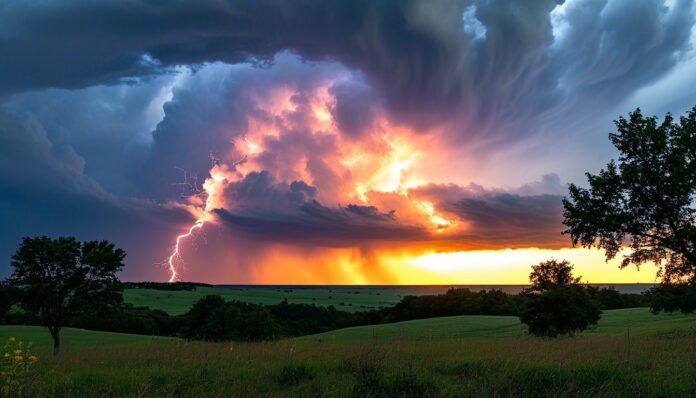Everyone sooner or later wonders what a thunderstorm is and why it makes some people hide under the bed while others are mesmerized by it. In this article, we’ve gathered the most interesting facts and information about thunderstorms that everyone should know.
A thunderstorm is usually defined as a combination of lightning and thunder. Thunderstorms are often accompanied by heavy rain, and sometimes even hail and powerful winds. These circumstances pose a certain danger to humans.
Among thunderstorm clouds, several types are distinguished, differing in severity and danger:
1. Single-cell thunderstorms – the weakest type. They disappear within an hour, often even less. They pose no threat and do not affect future weather conditions.
2. Multi-cell cluster clouds – the most common, observed everywhere, and do not cause much harm. They bring rain, mild winds, and last for several hours. Sometimes they can cause minor damage due to excessive precipitation.
3. Multi-cellular linear clouds – dangerous due to their powerful winds and often form severe hail. They are rarely observed in Europe, unlike North America. They are most dangerous for airplanes, helicopters, and other aircraft.
4. Supercell thunderstorms – these clouds pose the greatest danger but are very rare. They are accompanied by tornadoes and twisters, as well as heavy rainfall in the form of downpours and hail, and can last a long time. During such storms, it is advisable to stay at home or find another safe place.
How to protect yourself during a thunderstorm
Thunderstorms can cause considerable damage not only to humans but also to buildings, trees, and transportation. A lightning strike can cause a fire, and precipitation often forms huge puddles that are difficult to pass or drive through.
Moreover, quite often during a thunderstorm, gusty winds tear electrical wires from poles, the ends of which menacingly hang low to the ground. Try to stay away from such sparking wires. Heavy precipitation can flood basements and residential areas. Cases of unexpected falling trees onto the road or passing pedestrians are also not uncommon.
To protect yourself during a powerful thunderstorm, follow a few simple rules:
- Avoid high ground: tall trees, mountains, roofs, and towers. Try not to approach tall metal structures because lightning is most likely to strike there. Have you heard of lightning rods?
- Stay away from power lines. The reason has already been described above.
- During a thunderstorm, do not swim in enclosed bodies of water – for example, in a pool. If lightning strikes the pool, there is a high risk of electric shock. The consequences can vary from loss of consciousness to death.
- If you are at home, close windows and doors. The thing is, through the window, a so-called ball lightning can penetrate to you – a very dangerous and not fully understood phenomenon. People’s encounters with ball lightning are very rare, but still, it happens.
Interesting facts about thunderstorms
1. Thunderstorms are a dangerous natural phenomenon. Only floods and earthquakes are considered scarier than thunderstorms.
2. The probability of thunderstorm formation over oceans and seas is several times higher than over land.
3. Thunderstorms are most often observed in Africa, in its central parts, as well as throughout the equator. At the same time, thunderstorms are a very rare phenomenon in Antarctica.
4. Sometimes thunderstorms can create very strong tornadoes, the speed of which is comparable to the speed of sound.
5. The louder the sound of thunder, the closer the storm is to you.
6. Egypt experiences thunderstorms once every couple of centuries.
7. The Australian Tiwi Islands are famous for “Hector” – a thunderstorm cloud that appears in these places every day. Pilots have long determined by “Hector” that they are exactly above Tiwi.
8. The temperature at the point where lightning strikes is several times higher than the temperature of the sun’s surface.
9. The shockwave from thunder can shatter glass and knock down trees.
10. Argentina is famous for having the most powerful thunderclouds in the world.
11. Thunderstorms have been recorded on other planets, such as Jupiter.
12. The myth that lightning doesn’t strike the same place twice is just a myth. One person was struck by lightning twice in a row. There was only a few minutes between the two lightning strikes.
13. Every minute on the planet, about one and a half thousand thunderstorms are observed.
14. The speed of a thunderstorm can reach about eighty kilometers per hour.
15. Precipitation after a thunderstorm can amount to 20,000 cubic meters.
